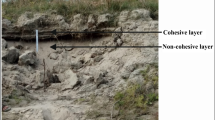Abstract
The configuration and safety factor of rockfill dams design depend on materials used in construction of the dam. In some regions, the available materials for using as impermeable element of the dam body are dispersive and it is inevitable to consider the dispersivity of the material in the design and construction. Internal erosion through cracks or other openings in the embankment is the most concern of using the dispersive soils. The authors have designed an embankment dam by using dispersive soil in East Africa after finalizing the dispersivity of materials based on the required tests. The foundation of dam and borrow areas consisted of dispersive soil and the effective measures has been considered in the design to safely deal with dispersivity according to recommendation of the design codes. The selected solution was the combination of chimney filter, filter drain, and selective placement of materials in the dam body as the effective solution considering the specification of the project. More precautions in addition to general recommendation have been incorporated into the design criteria due to placing the project in high hazard category. The local instability in the contact zones was the concerns of designers and bilinear parameters has been considered in the stability analysis as the base case. A drainage layer was added into half of the length of filter blanket and the feature of the design was determined according to nonlinear static and dynamic analysis of the dam body. This paper presents the measures and precautions that were taken into account in dealing with dispersive soil in order to ensure the safety of design.






Similar content being viewed by others
Availability of Data and Material
No problem, It can be shared as attachments of the article after confirming for publication.
Code Availability
Not applicable.
References
Fell R, MacGregor P, Stapledon D, Bell G, Foster M (2015) Geotechnical engineering of dams, 2nd edn. CRC Press, The Netherlands, p 1382
Guan P (2018) Marlborough dam construction challenges. New Zealand Geotechnical Society, NZ Geomechanics News
ICOLD (1990) Dispersive soil in Embankment dams, Bulletin 77, International Commission on Large Dams, Paris
Lesleighter EJ, Granger G, Buchanan P, Wark R (2004) EILDON dam spillway – spillway chute erosion assessment and protection, ANCOLD conference.
Hardie M (2009) Dispersive Soils and Their Management. Technical Reference Manual. Sustainable Land Use, Tas Dept of Primary Industries and Water, Hobart
Nagy G, Nagy L (2015) Identification and treatment of erodible clays in dikes. In: Schweckendiek VT et al (eds) Geotechnical Safety and Risk. IOS Press, pp 535–539
Paige-Green P (2008) Dispersive and erodible soils—fundamental differences. SAIEG/SAICE Problem Soils Conference, Midrand, November 2008, pp 59–67.
Richards KS, Redd KR (2007) Critical appraisal of piping phenomena in earth dams. Bull Eng Geol Environ 66:381–402
Sayehvand S, Dehghani M (2014) Identification and management of dispersive soils. EJGE 19:9023–9033
Singh B, Gahlot PK, Purohit D (2018) Dispersive soils-characterization, problems and remedies. Int Res J Eng Technol (IRJET) 5(6):2478–2484
SMEC (2020), Concept design report: mole river dam, Employer: Water NSW , Australia
Swindon A, Fell R, Herweynen R, Griggs T (2003) CAIRN CURRAN dam upgrade – investigations and geotechnical modelling, ANCOLD conference.
Tosun H (2006) Internal erosion resulted from dispersive soils in earthfill dams and a case study, Dam Safety 2006, ASDSO annual conference
USBR U.S. Department of the Interior Bureau of Reclamation (1991) Characteristics and problems of dispersive clay soils.
USBR U.S. Department of the Interior Bureau of Reclamation (2014) Design standards no. 13, Embankment Dams.
USDA (United States Department of Agriculture) (1991) Soil mechanics note no. 13 - Dispersive Clays.
Acknowledgements
Not applicable.
Funding
No funding was received to assist with the preparation of this manuscript.
Author information
Authors and Affiliations
Contributions
All authors contributed to the study conception and design. Mr. S performed stability and seepage analysis and interpreted the results regarding the static and non-linear & dynamic stability analysis of the dam body. Dr. H performed the literature review, coordination for the required geotechnical information, and the assumptions considering the design feature. He also prepared the text of the paper based on the performed analysis by Mr. S.
Corresponding author
Ethics declarations
Conflict of interest
On behalf of all authors, I acknowledge that there is no conflict of interest.
Ethical Approval
Hereby, I Ali Heidari consciously assure that for the manuscript “Embankment dam design with dispersive soil: Solutions and Challenges” the following is fulfilled: The paper reflects the authors' own research and analysis in a truthful and complete manner. The paper properly credits the meaningful contributions of co-author and co-researchers. The results are appropriately placed in the context of prior and existing research. All sources used are properly disclosed (correct citation). Literally copying of text must be indicated as such by using quotation marks and giving proper reference. All authors have been personally and actively involved in substantial work leading to the paper, and will take public responsibility for its content.
Consent for Publication
We, Ali Heidari & Davood Salehi give our consent for the publication of identifiable details, which can include photograph(s) and/ case history and/or details within the text (“Material”) to be published in the Journal and Article. Therefore, anyone can read material published in the Journal.
Additional information
Publisher's Note
Springer Nature remains neutral with regard to jurisdictional claims in published maps and institutional affiliations.
Rights and permissions
About this article
Cite this article
Salehi, D., Heidari, A. Embankment Dam Design with Dispersive Soil: Solutions and Challenges. Geotech Geol Eng 40, 4289–4299 (2022). https://doi.org/10.1007/s10706-022-02153-2
Received:
Accepted:
Published:
Issue Date:
DOI: https://doi.org/10.1007/s10706-022-02153-2




